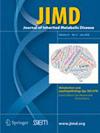筛选和诊断溶酶体疾病:生化和基因组方法
IF 3.8
2区 医学
Q1 ENDOCRINOLOGY & METABOLISM
引用次数: 0
摘要
迄今为止,已有超过60种溶酶体疾病被描述,分子(即下一代测序)和生化(即质谱)基因检测的持续进步将增加这一数字。与此同时,通过允许同时测量多种酶活性和/或生物标志物浓度,以及通过更少的测试快速生成基因组信息,同样的进步提高了实验室效率。在这里,我们提供了一个概述,目前可用的生化和分子遗传学测试,以及他们如何和他们的相互关系可以支持筛选,诊断和监测溶酶体疾病患者。本文章由计算机程序翻译,如有差异,请以英文原文为准。

Screening and Diagnosis of Lysosomal Disorders: Biochemical and Genomic Approaches
More than 60 lysosomal disorders have been described to date, and continued advancements in molecular (i.e., next generation sequencing) and biochemical (i.e., mass spectrometry) genetic testing will increase this number. In parallel, the same advancements have improved laboratory efficiency by allowing the simultaneous measurement of multiple enzyme activities and/or biomarker concentrations, as well as the rapid generation of genomic information with fewer tests. Here, we provide an overview of currently available biochemical and molecular genetic tests, and how they and their correlation to each other can support screening, diagnosis, and monitoring of patients with lysosomal disorders.
求助全文
通过发布文献求助,成功后即可免费获取论文全文。
去求助
来源期刊

Journal of Inherited Metabolic Disease
医学-内分泌学与代谢
CiteScore
9.50
自引率
7.10%
发文量
117
审稿时长
4-8 weeks
期刊介绍:
The Journal of Inherited Metabolic Disease (JIMD) is the official journal of the Society for the Study of Inborn Errors of Metabolism (SSIEM). By enhancing communication between workers in the field throughout the world, the JIMD aims to improve the management and understanding of inherited metabolic disorders. It publishes results of original research and new or important observations pertaining to any aspect of inherited metabolic disease in humans and higher animals. This includes clinical (medical, dental and veterinary), biochemical, genetic (including cytogenetic, molecular and population genetic), experimental (including cell biological), methodological, theoretical, epidemiological, ethical and counselling aspects. The JIMD also reviews important new developments or controversial issues relating to metabolic disorders and publishes reviews and short reports arising from the Society''s annual symposia. A distinction is made between peer-reviewed scientific material that is selected because of its significance for other professionals in the field and non-peer- reviewed material that aims to be important, controversial, interesting or entertaining (“Extras”).
 求助内容:
求助内容: 应助结果提醒方式:
应助结果提醒方式:


